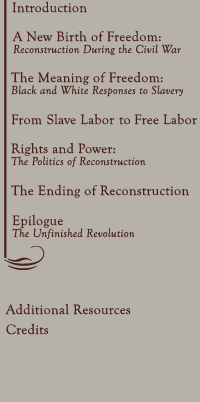

![]()

Epilogue: The Unfinished Revolution In the generation after the end of Reconstruction, the Southern states deprived blacks of their right to vote, and ordered that public and private facilities of all kinds be segregated by race. Until job opportunities opened in the North in the twentieth century, spurring a mass migration out of the South, most blacks remained locked in a system of political powerlessness and economic inequality. A hostile and biased historical interpretation of Reconstruction as a tragic era of black supremacy became part of the justification for the South's new system of white supremacy. Not until the mid-twentieth century would the nation again attempt to come to terms with the political and social agenda of Reconstruction. The civil rights movement of the 1950s and 1960s is often called the Second Reconstruction. Its achievements were far-reaching. Today, racial segregation has been outlawed, blacks vote on the same terms as whites, and more black Americans hold public office than ever before. Like the first Reconstruction, however, the second failed to erase the economic inequalities that originated in slavery and were reinforced by decades of segregation. Many black Americans have entered the middle class, but unemployment and poverty remain far higher than among whites. Some
Americans believe the nation has made major progress in living up
to the ideal of equality. Others are more impressed with how far
we still are from that ideal.
|